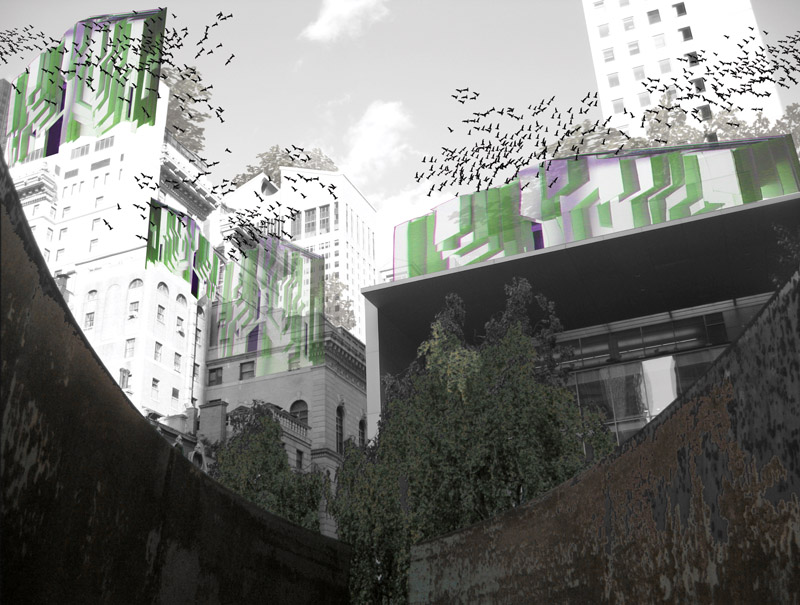2012, Past Futures, Present, Futures: Storefront for Art and Architecture, New York, NY
“Experimental Habitat for New York Rooftops” is a commissioned ‘reenactment’ of the Experimental Greenhouse for the courtyard of U.N. International School in New York by Experiments in Art and Technology (E.A.T.), 1970, one of 101 unrealized proposals for New York City included in the Past Futures, Present, Futures exhibition at Storefront, curated by Eva Franch. For a full description of the exhibition, its participants, and its designers, see: http://storefrontnews.org/programming/events?e=489&preview=true

EXPERIMENTAL HABITATS FOR NEW YORK ROOFTOPS: EXPANDED STRATEGIES TOWARD FOOD SECURITY
Year: 2032 (5 more Presidential Election Year Cycles)
Citizens of New York City have turned toward outdoor rooftop farming in lieu of attempting to establish uber-controlled plastic greenhouses. The reasons are simple: they see the urban rooftop as part of an outdoor landscape, a destination from which they can enjoy views of the city and breathe fresh air. By 2020, however, it has become increasingly difficult to productively grow food on rooftops, as plant-eating ‘pest’ populations have become resilient to ‘safe’ chemical pesticides. Further, natural pesticides and pollinators – such as birds, bats, and bees – have been disappearing from the city due to the propagation of urban bird-deterrents (i.e. nets and spikes on cornices) and other pest-control devices.
The Experimental Habitats Project aims to re-introduce wildlife habitats into the city, using rooftops as a new ground condition. Habitats will be developed prior to implementing rooftop farms. It is the goal that each rooftop will ultimately host interdependent ecologies of flora and fauna.
Experimental Rooftop Habitats and Farms would include these components:
1. Structures to facilitate wildlife inhabitation (wildlife walls, bat houses, bird nesting areas, bee hives, etc.): These would not only provide spaces and conditions for species to inhabit, but would also protect them from the wind and provide appropriate warmth.
2. Wind Protection Walls (especially for high altitude rooftops): It is advisable that each rooftop incorporate a series of walls or other wind buffers to protect potentially sensitive wildlife habitats was well as crops or other plants.
3. Water Infrastructure: This would tap into the building’s existing water system by siphoning off its greywater, filtering it, and holding it in existing water storage tanks (or other fabricated tanks). This water would be used for watering crops, and should also be easily accessible to the rooftop’s wildlife inhabitants.
4. Farming Areas: These zones are located so that rooftop structures do not block sunlight from crops and vegetation. Farming beds would be built in a way that would opportunistically use heat exhausted from the building or heat transfer through the roof, in order to prevent crops from freezing in the colder months. Farming areas should also include additional vegetation to encourage an increase in biodiversity.
Experimental Habitats are intended to serve as prototypes for developing a system of ‘Productive Wilderness’ (that is, wilderness that aids in a holistic system of farming) which can be repeated elsewhere in the city.
Projected Context: NEW YORK
Inhabitants: 9,999,999
Political System: The Green Party
Local Fact of Relevance: Zoning Ordinances have been modified to include a new category – Urban Wilderness.
Projected Context: WESTERN CULTURE
Literature: Interpretations of the Occupy Movement
Art: Public
Architecture: Constructed from recycled building materials
Film: Documentaries about ecological and political disasters
Music: Uses sounds sampled from ultrasonic recordings
Design: Designer paraphernalia for urban camping.
Technology: GPS-equipped cockroaches have been proven to find earthquake victims trapped in rubble.
Science: Scientists have successfully made bullet proof clothing by cross-breeding spiders and goats.
Medicine: Produced from bioengineered plant hybrids
New Terms/ Neologisms: Intensified Nature
Obsolete Terms: Business Casual
Random: The United States is in the process of exploring alternative economies.
Projected Context: WORLD
Population: 10,000,000,000
Global Fact of Relevance: New York is no longer the financial capital of the world, and China has outpaced the United States in terms of Olympic Medals.